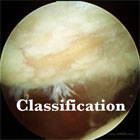|




|
synonyms: Knee scope, knee arthroscopy, KATS
Knee Scope CPT
Knee Scope Indications
- Mechanical knee symptoms
- Meniscal tear
- ACL tear
- OCD
- Patellofemoral Pain
- Discoid Meniscus
- Chondromalacia Patella
- Meniscal Cyst
- Chondral Injury / Lesion
- PVNS
Knee Scope Contraindications
- Infection
- Advanced arthritis
- Inadequate trial on non-operative treatment
Knee Scope Alternatives
- Non-operative management
- Open surgery
Knee Scope Pre-op Planning / Special Considerations
- Standard portals: inferomedial and inferolateral portals
- Posteromedial portal: 1cm above the joint line, behind the MCL; risks Saphenous nerve; allows view of posteior horns of menisci and PCL.
- Posterolateral portal: 1cm above the joint line, between LCL and biceps tendon; risks common peroneal nerve; allows view of posteior horns of menisci and PCL.
Knee Scope Technique
- Pre-operative antibiotics, +/- regional block
- Supine position. All bony prominences well padded.
- General endotracheal anesthesia vs MAC.
- Examination under anesthesia: ROM 0-130; varus laxity ext/30; valgus laxity ext/30; anterior drawer ER/IR, posterior drawer; lachman; pivot shift; ->10 degree increase in ER at 30 degrees flexion, but not at 90 degrees.
- Tourniquet high on thigh, but not inflated, popliteal post & lateral post or arthroscopic knee holder.
- Prep and drape in standard sterile fashion.
- Inferior lateral arthroscope portal made with 11 blade, blunt obturator and cannula.
- Evaluate suprapatellar pouch (synovitis).
- Patellofemoral joint: trochlear groove, medial and lateral facets of patella, assess patellar tracking.
- Lateral gutter, medial gutter.
- Inferior medial arthroscopy portal: 18 gauge spinal needle, 11 blade, blunt obturator, probe/etc.
- Medial compartment: MFC, MTP, medial meniscus.
- Notch: ACL, PCL
- Lateral compartment: LFC, LTP, lateral meniscus, popliteus.
- See also: Meniscal Tear Classification, Chondral Injury Classification,
- Accessory portals: Posteromedial=1cm above the joint line, posterior to the MCL, risks saphenous nerve/vein, aids visualization of PHMM, PCL. Posterolateral=1 cm above the joint line, between the LCL and the biceps tendon, risks common peroneal nerve.
- Close portal sites.
Knee Scope Complications
- Overall complication rate = 1.85% (Small NC, Arthroscopy 1988;3:215)
- Iatrogenic chondral injury (most common complication)
- Hemarthrosis / hematoma
- DVT: 9.9%, proximal DVT rate = 2.1% (Ilahi OA, Arthroscopy, 2005;21:727)
- Stiffness / Arthrofibrosis
- Arthritis
- Infection
- NVI (saphenous neuralgia)
- Fluid Extravasation / Compartment Syndrome
- Complex Regional Pain Syndrome: rare
- Synovial fistula
- Instrument Failure
- Risks of surgery include but are not limited to: incomplete relief of pain, incomplete return of function, chondral injury, hemarthrosis / hematoma, DVT, knee stiffness, arthrofibrosis, arthritis, infection, nerve or vascular injury, fluid extravasation, compartment syndrome, Complex Regional Pain Syndrome, synovial fistula, and the risks of anesthesia including heart attack, stroke and death.
Knee Scope Follow-up care
- Dependent on diagnosis and treatment.
- Partial medial meniscectomy: WBAT with crutches as needed. Home ROM and strengthening program.
- Knee Arthroscopy Rehab Protocol.
Knee Scope Outcomes
Knee Scope Review References
|